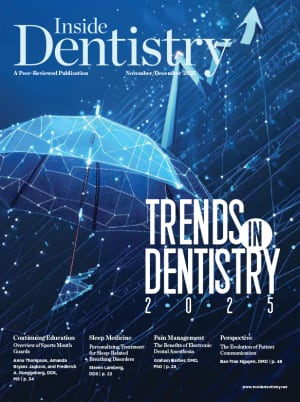April is oral cancer awareness month-an annual observation aimed at raising awareness among the public and providing education about the disease, including its risk factors, signs, and symptoms. It is also a time to raise awareness among oral healthcare professionals.
In our April cover story, Inside Dentistry examines the incidence, mortality, risk factors, and pathology of oral cancer and explores some of the new technologies being developed to enhance screening and management. Early diagnosis can significantly improve survival. As you'll learn in the article, clinicians are increasingly moving beyond the basic visual and tactile examination and integrating multiple screening modalities to enhance early detection. These include brush biopsies, salivary diagnostics, and fluorescence visualization. Dentists also play a key role in the management of side effects of the disease and its treatment, including performing necessary pretreatment extractions to prevent osteoradionecrosis and providing posttreatment salivary stimulants for xerostomia and photobiomodulation therapy to reduce pain and stimulate healing.
Some research indicates that oral cancer screening efforts by dentists and hygienists may be lacking in some areas, so I believe that it's important for me to emphasize the critical significance of this role in our profession. The incidence of oral cancer is low, which can make screening for it difficult to keep top of mind among other priorities. In 39 years, I have screened thousands of patients and sent hundreds for biopsies but have diagnosed less than half a dozen cases. However, I've supported two colleagues who are dear friends as they navigated treatment for oral cancer and survived. The severity of the skin burns caused by radiation therapy as well as the damage to the intraoral structures is something that you wouldn't wish on your worst enemy. Actually seeing what these patients go through really drives home the gravity of screening efforts to improve early detection. I believe that I've always been vigilant in screening, but perhaps seeing the effects of the disease firsthand made me more vigilant? Nonetheless, we should all always be vigilant. Make regular screening a part of your practice, schedule a 2-week follow-up for any suspected cases, and if indicated, refer patients to an oral surgeon for biopsy.
Robert C. Margeas, DDS
Editor-in-Chief, Inside Dentistry
Private Practice, Des Moines, Iowa
Adjunct Professor • Department of Operative Dentistry
University of Iowa, Iowa City, Iowa
robert.margeas@conexiant.com
